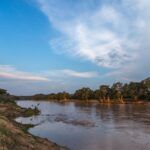The Olifants River
The Olifants River originates in the Winterhoek Mountains. Its upper catchment area is around Ceres and the Cederberg mountains. The river flows to the northwest through a deep narrow valley that widens and flattens into a broad floodplain below Clanwilliam. Its main tributary is the Doring River. The river is about 265 km long with a catchment area of 46,220 km². The Olifants River drains into the Atlantic Ocean near Papendorp where the mouth of the Olifants River is split in two by an island. Here you can see some very interesting rock formations.
The Olifants Valley produces high-quality Honey, Rooibos Tea and excellent Wines, but the Valley is best known for its citrus plantations.
The dams along the river are:
- Clanwilliam Dam has a storage capacity of 127,000,000 cubic metres. It is a concrete gravity dam that was established in 1935. The wall was raised to its current height of 43m in 1964. The width of the wall is 235 m. The main purpose of the dam is to provide irrigation water for agriculture downstream.
- The Bulshoek Dam has a storage capacity of 7,500,000 cubic metres The dam is very popular amongst Bass Fishermen as it is home to some nice size Smallmouth and Largemouth Bass. The dam is also popular for water skiing, canoeing, tubing, and jet skiing.
The major towns below the Olifants/Doring River catchment area include Lutzville, Vredendal and Vanrhynsdorp which are situated in the lower catchment area and Clanwilliam and Citrusdal in the middle catchment area


